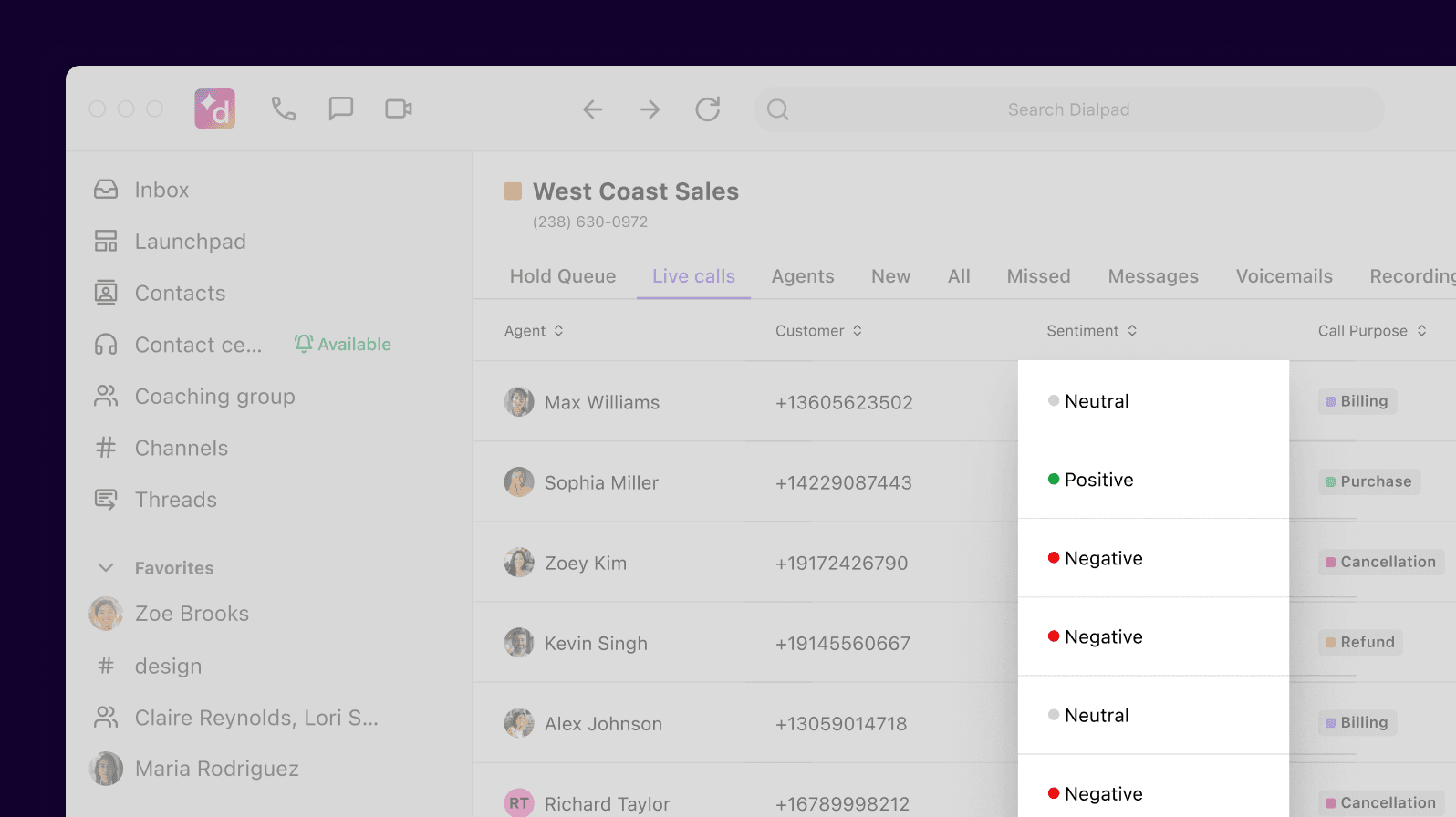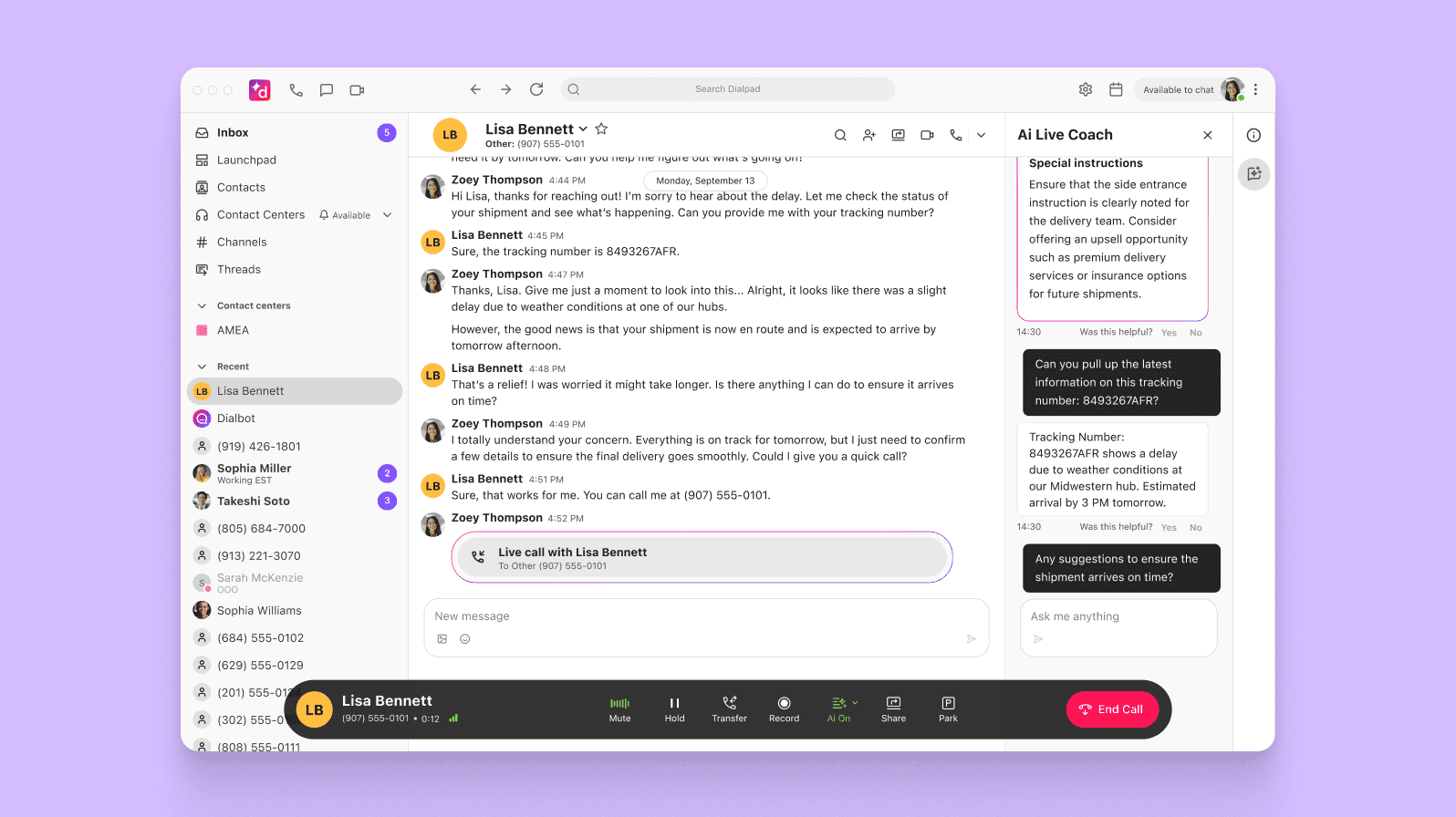How Ai is changing call centers (and 6 things to do)

Sr. Product Marketing Manager

Tags
Share
Call centers have long been environments where innovation thrives, constantly adopting new tools to streamline operations and enhance the customer experience. Today, artificial intelligence (Ai) is taking that transformation to the next level—not just improving the customer experience, but also making service faster, smarter, and more responsive than ever before.
From real-time transcription and sentiment analysis to predictive routing and automated follow-ups, Ai call center technologies like machine learning and natural language processing are reshaping how agents and supervisors operate. The result? Shorter wait times, quicker resolutions, and more personalized interactions—all at scale.
Let’s look at how Ai is helping call centers become more timely and efficient—and what that means for your customers, your agents, and your bottom line.
📚 Further reading:
Check out Dialpad's Ai adoption for contact centers: A leader’s guide to learn how to succeed in implementing Ai into contact center workflows.
The evolution of Ai in call centers: What’s changed
Ai has revolutionized the way call centers operate in quite a few ways already—and it's not a big reach to say that there will likely be even more improvements that we haven't imagined yet.
So far, here are a few key key stages of Ai's evolution in call centers:
From manual to automated call routing: Today, Ai-powered systems can analyze incoming calls and use algorithms to determine the most suitable agent to handle the specific query. This eliminates the need for manual call transfers and reduces wait times, ensuring customers are instantly connected to the best agent to answer their questions.
From human intervention on every customer question to virtual agents: Virtual agents, sometimes also called chatbots or conversational Ai, leverage Natural Language Processing (NLP) and Machine Learning (ML) algorithms to understand and respond to customer queries in real-time. These intelligent chatbots can provide instant answers without customers having to wait for hours on hold, which allows human agents to focus on questions that actually need their input.
From manual QA to Ai-assisted reviews and speech analytics: Before, a call center supervisor would have to listen to their agents' call recordings from beginning to end to do performance reviews and QA scoring. Today, Ai-powered speech analytics tools can analyze call recordings and transcripts to speed up this time-consuming process by suggesting whether the agent fulfilled the QA scorecard criteria. For example, Dialpad’s contact center platform is powered by Dialpad Ai, which can do this instantly for all of an agents' calls—supervisors no longer have to pick calls at random to review, and it reduces the chances of an unfair QA review because a manager randomly chose a really bad call to review.
6 ways call centers can empower agents and supervisors with Ai
1. Smarter real-time call routing
It wasn't that long ago that skills-based routing systems were a fresh concept, using customer profiles to pair callers with an agent whose skills were up to the task of assisting them. Increasingly, Ai and customer service automation can drastically speed up the process of determining which agent to assign to a call.
Today, contact center software with intelligent call routing systems use self-learning algorithms to analyze a combination of live and historical data: customer profiles, previous call outcomes, communication style, and behavioral signals. With this data, Ai can route calls more effectively, assigning simple questions to virtual agents or support chatbots, and sending complex or emotionally charged conversations to the most skilled human agent available.
This ensures that tickets are closed quickly and effectively and free up time across the board. Over time, this technology becomes more effective at making successful matches, which allows you to better respond to customers and improve their overall experience consistently.
2. Instant, actionable call analytics
There's a wealth of information in every customer interaction, and call center Ai is the key to capturing it all.
For example, live sentiment analysis can provide hints on how people feel about your brand, service, or products based on the words they use. Dialpad Support doesn't just transcribe customer calls in real time—it can also pick out positive and negative sentiment-related words and show supervisors which calls might need them to step in and help an agent with an irate customer:

With features like Natural Language Processing (NLP) and speech analytics, you can record customer service interactions and have them transcribed in an easy-to-read format. Transcriptions make it easy for supervisors to review conversations at a glance, pick up necessary details, and spot areas where agents need more coaching. (Learn more about NLP in customer service.)
Ai can also enhance contact center analytics, helping teams see larger patterns such as customer satisfaction, trending topics, and process gaps—all from a centralized dashboard. Supervisors can then adjust their strategies for interfacing with customers and improve their services to deliver a better experience.
3. Deeper insight into customer behavior
Building off of call analytics, Ai can make customer interactions more effective in several ways. For starters, the trends in customer behavior that Ai can identify will provide the early insight that call centers require to predict emerging customer needs and quickly develop best practices around them.
By building rich behavioral profiles and surfacing them in real time, Ai gives agents the context they need to personalize every conversation. Whether it’s adjusting their approach to customer retention, suggesting upsells based on customer history, or flagging churn risk, Ai empowers agents to shift from reactive to proactive service.
4. In-the-moment guidance that makes agents better
Today, agents no longer have to memorize product manuals or search through dozens of tabs to be good at their jobs. Ai is more than capable of helping agents provide the right answers almost instantly, in a wide range of situations.
Dialpad's Ai Live Coach, for instance, provides live feedback to agents during a customer conversation and also searches knowledge bases in real time to pull answers to challenging questions for agents who might be new or still ramping up:

Not only is this helpful to agents on a day-to-day basis, it also ensures that conversations adhere to your company’s internal standards and alerts managers when conversations veer from preset playbooks or require either intervention or follow-up action. This improves customer call quality over time, helps you further refine best practices, and reduces churn and dissatisfaction among callers and customers.
5. Scalable self-service and intelligent deflection
Ai isn't here to replace human agents—but it’s more than capable of handling repetitive, routine tasks so your team can focus on higher-value conversations. With conversational Ai, you can automate common workflows like password resets, appointment scheduling, or order tracking.
Virtual agents can guide customers through these tasks with natural, human-like dialogue, 24/7. Modern Ai call center software makes it easy to design these flows without writing a single line of code.
💡 Dialpad tip:
The thing to remember is in order for Ai to take on more significant self-service automations, you need to have accurate data so that Ai can correctly automate its responses to customers. Incomplete information limits the ability of Ai to manage more complicated interactions. Learn more about how to implement and get the most out of Ai on Dialpad’s Ai Hub.
For example, in Dialpad’s contact center platform, supervisors can easily set up conversational Ai dialogs in just a few clicks with the drag-and-drop builder:

6. Agentic Ai: The next frontier in human-Ai collaboration
The future of Ai in call centers goes beyond support—it's about autonomy. Agentic Ai represents a shift from reactive, tool-based assistance to Ai call center agents that can initiate tasks, coordinate workflows, and take action independently (within set boundaries, of course).
Imagine an Ai that not only suggests a follow-up email but also drafts it, personalizes it, schedules it, and sends it—all while logging the interaction in your CRM. Or an Ai assistant that can monitor service queues, reprioritize cases based on urgency, and nudge agents to switch focus in real time. (Learn more about agentic Ai use cases.)
Some contact center platforms, like Dialpad Support, are advancing toward fully integrated agentic systems that can deliver end-to-end automation and intelligence. This means businesses will be able to improve efficiency and scalability, and provide more personalized customer experiences without bloated tech stacks or patchwork solutions.
Call center Ai use cases
More and more businesses are recognizing Ai for the strategic asset that it is and leveraging it to transform how their customer support teams operate. While the exact applications vary by industry and platform, most use cases fall into a few core categories:
Automating routine tasks and data collection. Ai can handle repetitive, low-level interactions like password resets, order updates, or appointment confirmations—tasks that previously tied up human agents. It can also automatically collect and log data from calls, emails, and chats, freeing agents from tedious administrative work and ensuring that records are always up to date.
Analyzing customer interactions to uncover insights. Ai excels at parsing large volumes of data to identify trends, recurring issues, and customer sentiment. These insights help teams make smarter decisions, whether that’s improving agent training, identifying pain points in the customer journey, or refining product or service strategies. In other words, Ai-driven analytics can surface the why behind customer behavior, not just the what.
Enhancing agent performance in real time. Some call center Ai solutions support agents as they work, suggesting responses, retrieving knowledge base articles, and even coaching on tone and compliance. This reduces ramp-up time for new agents, boosts consistency across teams, and helps maintain high-quality service under pressure. (Learn more about Ai in customer service.)
Boosting operational efficiency through intelligent routing and workforce management. Ai-powered routing ensures every call or chat gets directed to the most appropriate virtual agent, self-service flow, or human rep with the right skills. Some workforce management platforms also come with Ai features that support more accurate forecasting and scheduling by predicting peak times, customer demand, and staffing needs.
Although many of these Ai capabilities have only emerged over the last few years, they’ve already proven valuable—especially in industries like banking and healthcare, where high-volume support environments demand both efficiency and quality. Leading organizations in these sectors have rapidly adopted Ai to streamline their support infrastructure and reduce time-to-resolution.
And while Ai won’t replace humans in call center roles entirely, its role is becoming more sophisticated and symbiotic. Rather than eliminating jobs, Ai takes on the repetitive, manual parts, enabling people to focus on the high-value, high-empathy work that builds long-term customer relationships. In that sense, Ai isn’t just a tool—it’s a force multiplier for businesses.
6 best practices for implementing Ai in your call center
1. Define clear objectives
Ai can automate processes, reduce wait times, improve agent coaching, and more, but without a clear objective, it’s easy to get distracted by flashy features.
Determine the specific goals you want to achieve with Ai implementation. That might be reducing call volumes, improving first call resolution rates, or improving your customer satisfaction scores.
Getting this clarity early on will guide your tool selection, implementation plan, and ROI tracking.
2. Prioritize change management from day one
Ai adoption isn’t just a technology shift—it’s a people and cultural shift. Even the best Ai tools can fall flat if your team isn’t aligned. Change can feel threatening or disruptive, so getting early buy-in and managing expectations is key to success.
Involve key stakeholders early, from IT and operations to team leads and frontline agents. Communicate clearly why you’re implementing Ai, what problems it solves, and how it supports your team.
Don’t forget to create internal champions or “Ai ambassadors” who can test features early and help train others. It’s critical to invest some time and energy into fostering a culture where Ai is seen as a co-pilot and not a replacement. This will help make your rollout feel collaborative, not top-down.
3. Integrate it with your other tools
Ai works best when it’s not siloed. Whether it’s a CRM, help desk, or ticketing platform, your Ai tools need to plug into your existing tech stack to share context, customer insights, and data in real time.
Audit your current tools and workflows to ensure compatibility. Look for contact center or call center Ai solutions with native integrations to your CRM (like Salesforce or HubSpot), unified communications tools, and analytics dashboards.
For example, Dialpad Support integrates with CRMs (Customer Relationship Management platforms) like Salesforce to transcribe calls in real time and pop up Ai-powered agent assists—right inside Salesforce:

4. Give your agents (ongoing) training and support
Technology is only as good as the people using it. Agents may feel overwhelmed or skeptical about Ai at first, especially if they worry it might replace their role.
Help them understand that Ai is here to support, not replace. A few ways to do this:
Deliver hands-on training for any new Ai features.
Share examples of how Ai can make their work easier (e.g. faster answers, less manual logging, better coaching).
Set up open feedback channels so agents can share what’s working or what’s getting in the way.
Reinforce that Ai is a tool for them—not something being done to them.
5. Continuously monitor progress and optimize where you can
It’s not enough to “set and forget” your Ai tools. You need to track performance, learn what’s working, and fine-tune regularly to drive meaningful impact.
Establish a baseline for your key metrics (e.g., CSAT, AHT, call deflection rate, ticket resolution time) and monitor progress weekly or monthly. Ideally, use platforms that have built-in analytics tools to make it easier to identify friction points or underused features.
6. Make sure your Ai shift is built on a foundation of trust and data privacy
Since Ai relies on large amounts of customer data and communication logs, it’s essential to handle that information responsibly. Customers expect transparency (and regulators are increasingly demanding it).
Here are a few tips to keep your Legal team happy:
Work with your Legal and Compliance teams to ensure your Ai tools meet relevant data protection standards (For example, Dialpad protects all conversations and data with enterprise-level encryption, role-based access, and more—and it helps customers maintain GDPR and HIPAA compliance—just to name a few security measures).
Use Ai platforms that offer robust data handling controls — including data anonymization, secure storage, and the ability to audit any Ai decision-making.
Clearly communicate to both agents and customers how data is used and protected.
Establishing trust early helps avoid legal risk and ensures your Ai initiatives are sustainable long term.
Ai in your call center: How will you use it?
Even though we’re still in the early stages of adoption, the landscape has already changed, with more and more businesses moving toward using Ai-based call centers—and the change is accelerating.
For agents, Ai eliminates time-consuming manual tasks like taking notes or searching for answers mid-conversation. Real-time guidance and automated assistance help them respond more confidently and accurately, reducing stress while improving customer satisfaction.
Supervisors benefit from instant visibility into live sentiment, call quality, and team performance. With these insights, they can offer targeted coaching, step in when needed, and track trends across hundreds or even thousands of conversations. At the same time, business leaders are using Ai to uncover high-level patterns in customer behavior, optimize staffing, and improve decision-making with accurate, real-time data.
Whether it’s streamlining workflows, improving response times, or elevating the customer experience, Ai has quickly become an indispensable tool in modern contact centers. And this is just the beginning. With the right tools and implementation strategy, Ai can help your teams work smarter, your operations run smoother, and your customers feel truly heard.
See how Dialpad Support uses its industry-leading built-in Ai to help contact centers deliver faster, more personalized service with less effort.
Use Dialpad Ai to improve your call center performance
Book a demo or take a self-guided interactive tour of the app to see how it works!
